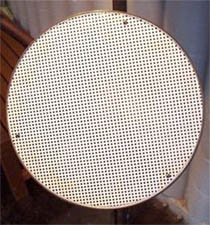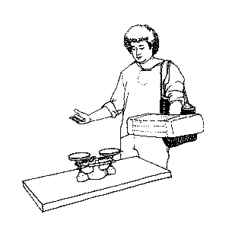![]()

|
KEY: |
|||
|
|
|
||
|
|
Refers to the exhibit graphics and the instructions in them |
||
|
|
Refers to things to do not suggested in the instructions on the exhibit |
||
Normally we trust our senses, but sometimes we can't - and this is the most disorienting thing of all... Our bodies have mechanisms to tell us if we're right side up or upside down, moving or standing still, or looking at or hearing something near to us or far away. But as you'll find out along this Pathway, our bodies can also be fooled. There are lots of things that disorient or unbalance people- for example: heights, ocean voyages, mirrors, fevers, or being underwater.How do you keep balance? What do you rely on to do this? What things put you off balance? When is it hard to stay balanced? What's your definition of an illusion?

![]()
Are you sure you know when you're moving and when you're standing still?
![]()
Make sure your friend holds the wall perfectly still for the time you're standing on one leg. And that they then move the wall very slowly and evenly in one direction.
- What
happened?


- Try
it again. Did the same thing happen? If not, how was it
different?


- Why?


![]()
In this exhibit, you learn to do something difficult, and then you have to "unlearn" it in order to do something easy!
![]()
- With
the prism goggles on, how many throws does it take you to
make a basket?

- After
making fifteen shots with the goggles on, take them off
and try a shot. How many throws does it take with the
goggles off?

![]()
You can repeat this experiment but this time try throwing with your other arm after you take the goggles off- that arm isn't "trained" like the other one.
- What
happens?



![]()
With this exhibit, you can practice being a figure skater, an astronaut, or going on amusement park rides without getting sick!
![]()
- What
happens when you extend your arm or leg while
spinning?


- What
happens when you bring them back in?


![]()
Ballet dancers use a method called "spotting," where they keep their eyes trained on a certain spot while spinning around. Their head "lags behind" the rest of their body for half of the spin, and then they quickly turn their head, stopping to focus on the exact same spot again and again.
1. Does this work for you?
Some people will be able to do this quickly, but for most it takes a good deal of practice.
If
you want to avoid nausea (you can't really avoid dizziness
though!), whatever you do, don't tilt your head up and down
or keep your chin pointed at your chest as you're spinning!
Closing your eyes is probably a bad idea too- you'll get
conflicting signals from your eye and the semicircular
canals in your ear (see below). Do you get queasy while
reading on the bus? Same effect. A
part of your inner ear called the semicircular
canals contains a fluid, called endolymph, that
flows over nerve endings and informs you of changes
in your body's movement. Spinning around sets this
fluid spinning too and it's own momentum keeps it
moving even after you've stopped. You'll probably
feel dizzy while you're waiting for it to settle
down. These canals also help tell you which way
your body is oriented, much like the fluid in a
carpenter‚s level. If your head is tilted
while the fluid is sloshing around, this mechanism
sends the signal to your brain that you are not
upright- but your own eyes contradict this! This
contradiction tends to make people
nauseous.
![]()
After spinning fast, get off the machine and try walking in a straight line (you can ask your friend to judge).
2. Can you do it? Did you experience a slight feeling of loss of control?

![]()
Your "eye-brain" system has built-in detectors of inward and outward motion. If one detector gets tired, as when you stare at the pattern, the other one can override it when you look at something stationary, and even objects standing still appear to move towards or away from you.
![]()
What's
the connection between how the spirals appear to move and
how the wall appears to move afterward?

![]()
Sometimes your brain alone makes things move.
![]()
- What
is the same about this exhibit and Depth Spinner?


- What
is different?



![]()
Why does that big tree in the distance seem to be no bigger than my finger?
![]()
Try touching the two bent rods together.
- When
looking through the prisms, did your perception turn out
to be different from reality? How?


- Can you use your brain to make perception and reality match?
![]()
Make one of the rods pass in front of the other.
- How
does this affect the illusion?


- Is
there anything else that "breaks" the illusion?


![]()
We're better at seeing something moving than we are at seeing something standing still.


![]()
- Describe
what happens to your friend's face.


![]()
If the movement of one of your hands can make all or part of the image disappear, the eye corresponding to that hand is likely your dominant eye.
- Which
is your dominant eye?

For further experiments with similar aspects of your vision, check out the exhibits Two as One, Motion Detection, and Peripheral Vision.
- What's
the connection among these exhibits ?



![]()
When we think in three dimensions, the power of our imagination can be a startling thing.
![]()
Putting the dark plastic over one eye can delay its vision slightly.
- What
is the effect on you?


Some people can make the shadows switch direction just by thinking about it!
- Can
you?



![]()
The spring really is in the box somewhere! But what you see is a very good reflection.
![]()
- Where
IS the spring, actually?


- Why
does the reflection appear to have a shadow when you
shine the light on it?



![]()
Don‚t get fooled again.
- What
is the key to the illusion?


![]()
Try putting other objects where the key really is. Try your hand.
- What
happens?


- Where
else have you seen an illusion like this?



![]()
Looking in a mirror can really make you forget yourself.
![]()
- What
happens when you move the hand you can‚t see?


![]()
Have a friend put their hands on the bar, one on each side of the mirror. Make sure they are only looking at one side. Now, put your index fingers on the back of each hand, and slide them along in an even, parallel motion. Do this several times, and then without warning remove the finger from the hand that your friend can see, while continuing on the hand they cannot see. Have them do the same for you.
- Describe
what you feel.


![]()
Is this how dolphins see the world?
![]()
- What
is it like to see your hand underwater? Does it look
wet?


- Try
to catch some air in your palm. What does it look
like?



![]()
Heavy things can come in small packages, and vice versa…
![]()
- What
do you think makes it difficult to guess correctly?


- What
is the difference between density and weight?


